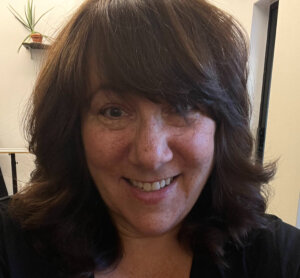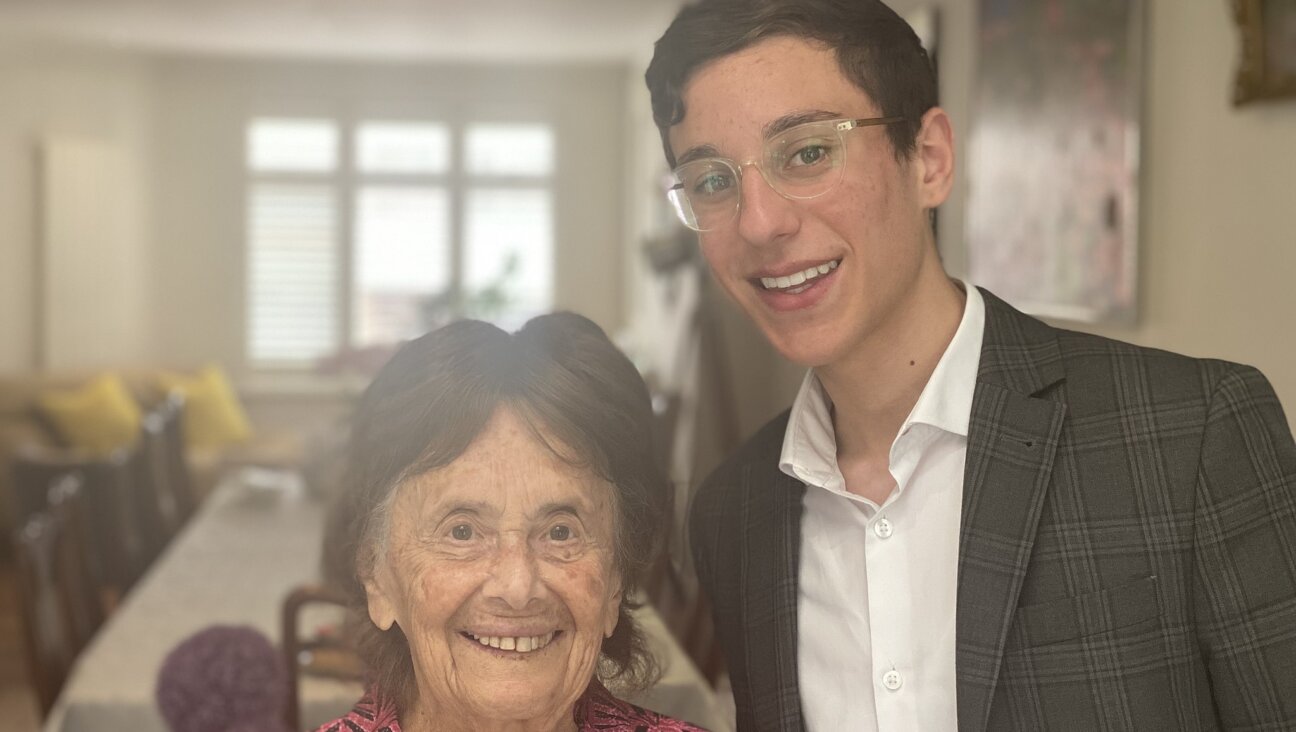The Liberation of Helène Aylon

Image by Courtesy of the Feminist Press

Open Books: Aylon?s ?The Liberation of G-d? physically critiques the Bible without defacing it. Image by Helène Aylon, ?the liberation of g-d, 1990-1996
Whatever Is Contained Must Be Released:
My Jewish Orthodox Girlhood, My Life as a Feminist Artist
By Helène Aylon
The Feminist Press, 350 pages, $29.95
Walking through the “Too Jewish?” exhibit at Los Angeles’s Hammer Museum back in 1997, surveying the artistic commentaries on popular tropes of American Jewish culture — big noses, Barbra Streisand, a Christmas tree festooned with Jewish stars, Hasidic men’s black coats — I thought: “Is this it? Is this all any of these artists can say about Judaism and Jewish culture?”
Then I stepped inside the show’s concluding installation, a sukkah-sized room with walls lined with dozens of copies of the Five Books of Moses. Vellum overlaid the holy text, and every misogynistic or violent phrase was highlighted on the vellum in pink. Called “The Liberation of G-d,” the work demonstrated the intrinsic value of our most sacred book by not defacing the actual pages, even as the artist brought a modern woman’s critique to bear on it. This, I thought, is a knowledgeable artist who has something interesting to say.
Outside sat a woman in an artsy head wrap and flowing clothes, surrounded by men wearing yarmulkes. It was the artist, Helène Aylon, talking with local rabbis about her piece. She and I met that day, and we have been friends ever since.
Now Aylon has written a memoir, “Whatever Is Contained Must Be Released: My Jewish Orthodox Girlhood, My Life as a Feminist Artist.” The book traces her journey from nice Jewish girl raised in the Orthodox enclave of Brooklyn’s Boro Park to rebbetzin and mother, and then to young widow and feminist artist. At 81, Aylon now has work in the permanent collections of, among other museums, New York City’s Whitney Museum of American Art, Museum of Modern Art and The Jewish Museum. She was recently featured in the show “Matronita” at Israel’s Ein Harod Museum of Art, and has a piece, “Hagar and the Tree That Was Not There,” in the current exhibit “Do Not Destroy: Trees, Art, and Jewish Thought,” at San Francisco’s Contemporary Jewish Museum. Last year her work was featured in Pittsburgh, at the Andy Warhol Museum.
Her book begins in her childhood home in Brooklyn. Helène Greenfield, as she was then named, was an artistic and spirited girl who wanted to attend the High School of Music & Art after graduating from Shulamith School for Girls. But Music & Art was in Manhattan, “which might as well have been a foreign country,” Aylon said, and Shulamith’s principal, who thought it better that girls stay close to home, dissuaded her. So Aylon attended a neighborhood high school and was signed up by her parents for a correspondence art course.
While still in high school, she became engaged to a rabbinical student. She married him in 1949, when she was just 18. Rabbi and Rebbetzin Mandel Fisch immediately moved to Montreal, where he had a pulpit. She imagined a bigger life for herself there, as a rabbi’s wife, than what awaited her if she remained in Boro Park. But even then, Aylon had doubts about God and about what it meant to be a good rebbetzin. She writes about how, when asked to give the invocation at their new synagogue, “I prayed to believe.”
Two years later, with a toddler son, Nat, and expecting a daughter, Renee, the couple moved back to Brooklyn, where he had a new job. Within a few years, Mandel was diagnosed with cancer. He died the week Aylon turned 30.
It didn’t take her long to learn just how different her life would be. A married male congregant immediately confessed his sexual fantasies about her. Shlomo Carlebach, who was a family acquaintance and not as famous as he would later become, would call to sing to her in the middle of the night. It made her feel “very alive, as though he was singing away the sediment of death.” But he invariably asked “if I was cold. I always said yes. Sometimes he would ask what I was wearing.”
Toward the end of her husband’s life, Aylon had enrolled at Brooklyn College as an art major. One of her early teachers and mentors was abstract expressionist painter Ad Reinhardt. He told Mark Rothko about her, and soon Rothko invited her to his studio. Their Jewishness, even more than their art, connected them, as they discussed Barnett Newman’s kabbalistic sculpture, “Tsim Tsum,” and Rothko’s childhood, which included attending heder in Russia. “It was a day of days,” Aylon told me recently, “a day I’ll never forget.” Three weeks after their meeting, Rothko committed suicide.
The year after she was widowed, Aylon painted a mural for a youth employment center in the Brooklyn neighborhood of Bedford-Stuyvesant. When a newspaper photographer came to take a picture of this white female artist surrounded by black youth, he asked her name. She spontaneously said, “Helène Aylon,” giving a Hebraicized version of her first name for her last. “It was a split-second decision,” she said. “I didn’t want to be Mrs. Fisch, as an artist. I also didn’t want to be one of the Greenfield Girls of Boro Park. The next day, people asked my mother if I’d remarried.” Her mother, with whom Aylon stayed close until her death in 2009, never agreed to call Aylon by her new last name.
Through college and the early years of establishing herself as an artist, Aylon raised two children on her own and struggled with the deep conflict produced by the effort to fully occupy the role of both mother and artist. “I felt guilty all the time,” she writes. Her mother, who didn’t understand her daughter’s artistic drive, heaped on the guilt. “Every day in my studio my mother would call and make me feel guilty about Renee being home by herself, while here I am shmearing [paint],” she said. “It was a really painful time.”
Aylon’s liberation came in 1970 with the advent of feminism, which she calls “my salvation.” It was “a rebirth that dazzled my imagination like a sunrise, and plucked me out of the guilt that was caving in on me,” she writes. “I was rescued by women like Maya Angelou, Andrea Dworkin, Adrienne Rich and Mary Daly. I realized that these role models did not tremble in their lives the way I did in my splattered smock.”
When her daughter went to college, Aylon moved to Westbeth, the artist’s housing complex in Manhattan’s West Village, and began sleeping with the young man she hired to walk her dog. He turned out to be not the jazz musician she thought, but a heroin addict. Friends invited her to drive with them to California, so she made a clean break from New York and talked her way into a job teaching at San Francisco State University. Aylon stayed in Berkeley for a decade.
In California, through the 1970s, she created “The Breakings” series, which today she calls her most important work. She poured linseed oil on large panels, letting them lie flat until the oil formed a thick skin. Months later she lifted the panels so that the wet oil formed a sac beneath the skin, which then broke, drizzling or gushing down the panel and creating something new. It was, Aylon writes, “very wet, orgasmic process art.” The paintings reflected her internal process: “I intentionally made paintings that change through natural means, such as a plant that grows, a face that wrinkles, a scar that heals.”
In the 1980s, Aylon turned her focus away from the body and toward the earth and anti-nuclear activism. For “Earth Ambulance,” she traveled to military bases, nuclear reactors and uranium mines. There she collected dirt in pillowcases, which she used to demonstrate outside the United Nations for the second special session on nuclear disarmament, in June 1982. In 1985 she went to Japan to mark the 40th anniversary of the atomic bombings of Hiroshima and Nagasaki. There she floated sacks filled with seeds, pods, grain and bamboo shoots downriver toward those cities.
Perhaps Aylon’s best-known work is her nine-part “God Project,” which starts with the “Liberation of G-d” Chumash installation and has spanned almost three decades. It began in 1984, when her son asked her to write the marriage contract for his wedding. In a traditional ketubah, the bride and groom are identified by only their fathers’ names, and because her son is traditionally observant, whatever she did required Orthodox approbation. But Aylon felt it wasn’t right to exclude the mothers’ names. She went from one Orthodox rabbi to another — six, in total — before finding Rabbi Yitz Greenberg, who allowed her to include the mothers’ names in the margins or on the back of the document.
Aylon put asterisks in the text where the mothers’ names would have been, and wrote the word “Ima” on the bottom margin, to stand “for all mothers.” “This small act of correcting an ancient text was the beginning; putting in the asterisks meant something was left out and I was correcting the omission,” she writes. Her next correction would be far more ambitious: the Torah itself.
Aylon spent the following six years highlighting each chapter of the Five Books of Moses. Each night, she made “a horizontal pink slash over the words of vengeance, deception, cruelty and misogyny — words attributed to G-d. In between words where the female presence was left out, I inserted a vertical pink line.” She continued her critique in the subsequent parts of the series, restoring the names of mothers — her own, and our biblical and historical — and interpolating a female perspective into Jewish rituals where none is codified.
Throughout her memoir, as in “The Liberation of G-d,” Aylon uses a pink dash between the letters G and D wherever the word “God” appears. In anyone else’s hands, this would seem like little more than a gimmick. But here it works. It means more than the letter o, omitted from written representations of the name of God by many observant Jews. It represents all that is missing from Jewish tradition as men have shaped it, and illustrates not only that the voices of women have been excluded, but also that what we all take to represent God is incomplete for their absence.
Aylon occupies a unique, sometimes uneasy place in the spectrums of Jewish art and feminism. She is more organic and less overtly political than other feminist artists, even as her work is more specifically Jewish and knowledgeable than that of most Jewish artists. She is not a maker of shtetl sentimentality, of wistful Shabbos scenes or reverential rebbe portraits. But her gaze is loving even when it is angry. This is what makes Aylon a compelling artist, and her memoir worth reading: Her ability to show the ways in which Judaism has controlled and confined her, as it has all Jewish women. And yet, to love it all the same.
Debra Nussbaum Cohen is a Forward contributing editor and the author of “Celebrating Your New Jewish Daughter: Creating Jewish Ways To Welcome Baby Girls Into the Covenant” (Jewish Lights Publishing, 2001).





















